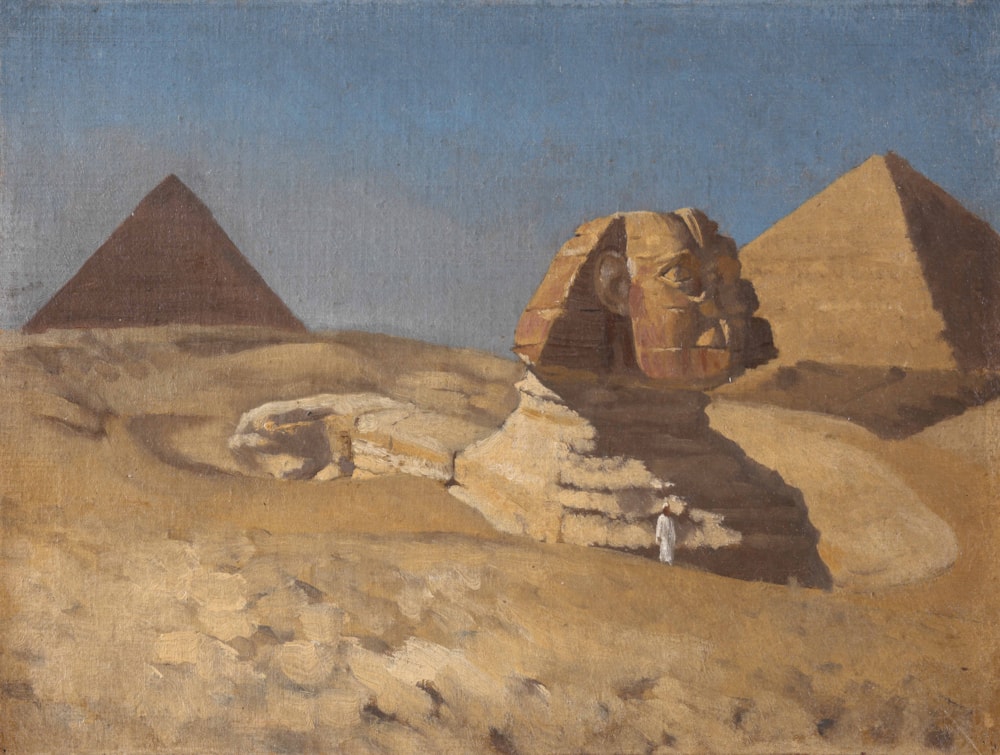Jean-Richard Goubie ( 1842 - 1899 )
The Great Sphinx of Giza, Egypt, 1868

The Great Sphinx of Giza, Egypt, 1868
oil on canvas
24 x 32 cm.
with studio stamp on stretcher
£7,500
item sold
It has been said that by 1880 Jean-Léon Gérôme (1824-1904) was perhaps the most famous living artist in the world, even though nowadays we mistakenly think of that extraordinarily fertile period in the history of art as dominated by the Impressionists. The opposite is in fact true, and in Paris it was still the age of the great academic painters, who achieved prodigious prices for their paintings and who had whole schools of students. Gérôme was lionized for his detailed and realistic scenes from Greek mythology, French history and from Egypt and the Middle East. His paintings of Arab religious practice, genre scenes and North African landscapes were at the forefront of the Orientalist movement in France, and were highly sought after by American collectors even in his lifetime.
Goubie, the painter of this shimmering oil study, was a pupil of Gérôme and, significantly, accompanied Gérôme on his ‘grand safari’, as he called it, to Egypt and the Near East in 1868. This was Gérôme’s third trip to the Orient, and the party included Albert Goupil (his brother-in-law and son of the famous dealer and printseller Adolphe) and the painter Léon Bonnat (1833-1922). Travelling from Marseille via Alexandria, the party spent a month in Cairo and then on 20th February left for Giza, where they camped for three days. By April they had reached the monastery of St. Catherine in Sinai; then, after an eventful stay at Petra, they reached Jerusalem, where one of the party revealed to the American painter Frederick Church that several of the party had been robbed of all their possessions by marauding bandits.
It is well-known that Gérôme set great store by his oil sketches done from nature for the backgrounds of his Orientalist subjects, to be complemented by and brought to life with his own collection of costumes and artefacts once back in Paris. ‘Even’, he wrote, ‘when worn out after long marches under the bright sun, as soon as our camping spot was reached I got down to work with concentration…I prefer three touches of colour on a piece of canvas to the most vivid memory.’ No further scrutiny of his pupil Goubie’s methods is needed, therefore, and it is rather thrilling to envisage the younger artist dutifully setting up his easel near the great man, in the blistering heat and in front of the most awe-inspiring monuments known to man. (For art historians, too, the episode reminds us that sketching from nature in oils had already begun many decades earlier, with Corot and his devotees, and that the term ‘en plein-air’ decisively pre-dates Impressionism.)
Goubie’s oil study shows us the view of the Sphinx from the south-east, the statue itself being orientated to face due east; to the right is the Great Pyramid, and beyond and in shadow the Second Pyramid, built by the pharaoh Khafra in about 2500 BC. It is this ruler, so current Egyptology has it, who is commemorated by the Sphinx itself, still one of the largest statues in the world. Goubie’s painting accurately shows the depredations of time, erosion and eighteenth-century Turkish vandals to the face, and also the fact that it was to be another thirty years before the front legs were uncovered.

